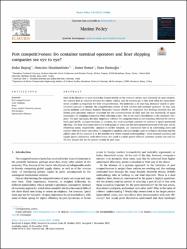| dc.contributor.author | Baştuğ, Sedat | |
| dc.contributor.author | Haralambides, Hercules | |
| dc.contributor.author | Esmer, Soner | |
| dc.contributor.author | Eminoğlu, Enes | |
| dc.date.accessioned | 2022-12-07T07:08:26Z | |
| dc.date.available | 2022-12-07T07:08:26Z | |
| dc.date.issued | 2022 | en_US |
| dc.identifier.citation | Baştuğ, S., Haralambides, H., Esmer, S., Eminoğlu, E. (2022). Port competitiveness: Do container terminal operators and liner shipping companies see eye to eye?. Marine Policy, 135, art. no. 104866.
https://doi.org/10.1016/j.marpol.2021.104866 | en_US |
| dc.identifier.uri | https://doi.org/10.1016/j.marpol.2021.104866 | |
| dc.identifier.uri | https://hdl.handle.net/20.500.12508/2407 | |
| dc.description.abstract | Most of the literature on port choice has focused mostly on the views of carriers (and indirectly of cargo owners). We venture here to discover whether the choice criteria used by carriers are in line with what the ports themselves consider as important for their competitiveness. We undertake a 20-year-long literature search in peer-reviewed journals to identify the competitiveness criteria of both carriers and terminal operators. To that end, survey methods and (Fuzzy) Analytic Hierarchy Process (FAHP) are employed. Our findings establish that the factors port operators consider important for the competitiveness of their port are not necessarily of equal importance for shipping companies when selecting a port. This is our main contribution to the academic literature. For port operators, the most important criterion for competitiveness is port location, followed by service level, port tariffs, and port facilities. In contrast, the most important criterion for carriers is (port) operational efficiency. The least important criteria for both groups of actors are the institutional framework of the port and its ownership status, respectively. Opposite to earlier research, our innovation here is in confronting ports and carriers with each other's priorities. In competitive markets, such knowledge ought to influence decisions and the added value of this research is in the benefits of a ‘better mutual understanding’: when demand (carriers) and supply (ports) understand each other better, the result is a more pareto-efficient economic system, not only for the two players but for the greater society by and large. | en_US |
| dc.language.iso | eng | en_US |
| dc.publisher | Elsevier | en_US |
| dc.relation.isversionof | 10.1016/j.marpol.2021.104866 | en_US |
| dc.rights | info:eu-repo/semantics/openAccess | en_US |
| dc.subject | Fuzzy analytic hierarchy process | en_US |
| dc.subject | Liner shipping | en_US |
| dc.subject | Operational efficiency | en_US |
| dc.subject | Port competitiveness | en_US |
| dc.subject | Port location | en_US |
| dc.subject | Ports | en_US |
| dc.subject.classification | Container Port | |
| dc.subject.classification | Short Sea Shipping | |
| dc.subject.classification | Harbors (Waterways) | |
| dc.subject.classification | Environmental Sciences & Ecology | |
| dc.subject.classification | International Relations | |
| dc.subject.classification | Electrical Engineering, Electronics & Computer Science
- Supply Chain & Logistics - Vehicle Routing Problem | |
| dc.subject.other | Analytical hierarchy process | |
| dc.subject.other | Competitiveness | |
| dc.subject.other | Container terminal | |
| dc.subject.other | Institutional framework | |
| dc.subject.other | Ownership | |
| dc.subject.other | Port operation | |
| dc.subject.other | Shipping | |
| dc.title | Port competitiveness: Do container terminal operators and liner shipping companies see eye to eye? | en_US |
| dc.type | article | en_US |
| dc.relation.journal | Marine Policy | en_US |
| dc.contributor.department | Barbaros Hayrettin Gemi İnşaatı ve Denizcilik Fakültesi -- Denizcilik İşletmeleri Yönetimi Bölümü | en_US |
| dc.identifier.volume | 135 | en_US |
| dc.relation.publicationcategory | Makale - Uluslararası Hakemli Dergi - Kurum Öğretim Elemanı | en_US |
| dc.contributor.isteauthor | Baştuğ, Sedat | |
| dc.contributor.isteauthor | Esmer, Soner | |
| dc.contributor.isteauthor | Eminoğlu, Enes | |
| dc.relation.index | Web of Science - Scopus | en_US |
| dc.relation.index | Web of Science Core Collection - Social Sciences Citation Index | |
















